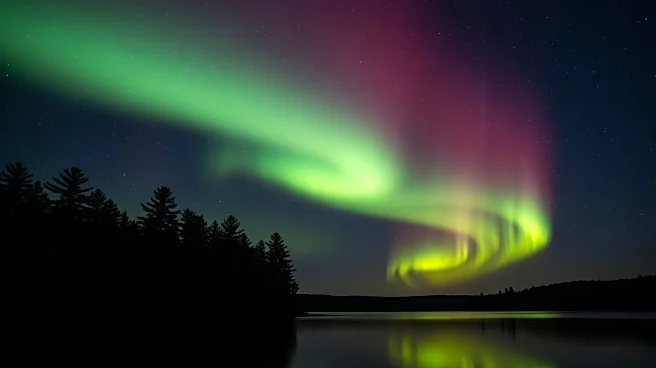What's Happening?
On November 11, 2025, a geomagnetic storm in southern Wisconsin led to the appearance of rare proton auroras. These auroras were observed by Kelly Kizer Whitt, who noted the unusual pulsating blobs of light
during the storm. The event followed a series of X flares from the sun, which resulted in ejected plasma impacting Earth's atmosphere. Proton auroras differ from ordinary auroras, which are typically caused by electrons. Instead, proton auroras occur when protons from a ring around Earth descend during strong geomagnetic storms, causing a secondary shower of electrons that produce the auroral display. These auroras can appear at lower latitudes than typical northern and southern lights and have the potential to affect the ozone layer.
Why It's Important?
The occurrence of proton auroras during geomagnetic storms highlights the dynamic interactions between solar activity and Earth's atmosphere. These auroras can have implications for atmospheric science, particularly concerning their potential impact on the ozone layer. Understanding proton auroras can contribute to broader research on geomagnetic storms and their effects on Earth. Additionally, the visibility of these auroras at lower latitudes expands the geographical scope of auroral studies, offering new opportunities for observation and analysis. The event underscores the importance of monitoring solar activity and its terrestrial consequences, which can affect communication systems, navigation, and power grids.
What's Next?
Further research may be conducted to assess the impact of proton auroras on the ozone layer, especially in light of their potential to create large holes. Scientists may also continue to study the conditions that lead to the formation of proton auroras, aiming to predict their occurrence and mitigate any adverse effects on technology and the environment. Observations from this event could inform future geomagnetic storm preparedness and response strategies, particularly in regions not typically associated with auroral activity.
Beyond the Headlines
The appearance of proton auroras in Wisconsin adds to the understanding of auroral phenomena and their variability. This event may prompt discussions on the broader implications of solar activity on Earth's climate and atmospheric conditions. The study of proton auroras could also intersect with research on space weather and its influence on human activities, emphasizing the interconnectedness of celestial and terrestrial systems.












